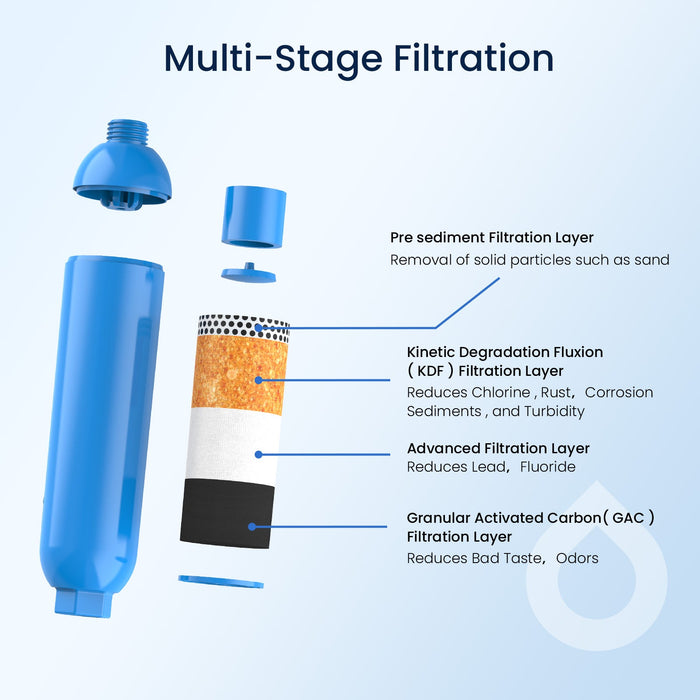Unlock the Secrets to Crystal Clear Water for Your RV Adventures!
When it comes to RV travel, having access to contaminant-free water is not just a luxury—it's a necessity. Clean water enhances your overall experience by ensuring that you stay healthy and hydrated while on the road. Unfortunately, many RV owners may not realize that their water systems can harbor a variety of contaminants that pose health risks. From harmful bacteria to unpleasant chemicals, these pollutants can affect not only the taste and quality of your water but also your well-being. Understanding the sources of these contaminants and taking the necessary steps to purify your water can make all the difference in your outdoor adventures.

Understanding Contaminants in RV Water Systems
RV water systems can be compromised by several types of contaminants. Common pollutants include bacteria, chemicals, and sediment. Bacteria such as E. coli and Giardia can enter your water supply from various sources, including contaminated water sources or inadequate tank cleaning. Chemicals, including chlorine and heavy metals, may leach into your water from old pipes or municipal supplies. Additionally, sediment can accumulate in your tanks, affecting both water quality and flavor. The presence of these contaminants can lead to gastrointestinal illnesses and other health issues, making it crucial to understand their origins and effects. Ensuring that your water is free from these pollutants will not only improve its taste but also protect your health during your travels.
Methods to Achieve Contaminant-Free Water
There are several methods available for purifying RV water, each with its own advantages and disadvantages. Filtration systems are among the most popular options, effectively removing impurities and improving taste. UV purification is another method that utilizes ultraviolet light to kill harmful microorganisms, ensuring safe drinking water. Lastly, chemical treatments, such as chlorine or iodine tablets, can disinfect water effectively but require careful handling and dosage. Understanding the pros and cons of each method will help you choose the best solution for your RV water needs, ensuring that you enjoy refreshing, contaminant-free water on your journeys.
Filtration Systems
Filtration systems come in various types, including activated carbon filters, which can remove chlorine, sediment, and other impurities, and reverse osmosis systems, which provide thorough purification by filtering out nearly all contaminants. Installing a filtration system in your RV can be straightforward, but regular maintenance is essential to ensure effective performance. Many RV enthusiasts recommend replacing filter cartridges every few months, especially if you frequently fill your tank from questionable water sources. A well-maintained filtration system can greatly enhance the quality of your water, making it safer and more enjoyable to drink.
UV Purification
UV purification works by exposing water to ultraviolet light, which effectively kills bacteria and viruses without the need for chemicals. This method is highly effective and leaves no chemical taste, making it a popular choice for many RVers. However, it requires a clear water source to be effective; cloudy or sediment-heavy water can hinder the purification process. Additionally, UV systems require a power source, so consider your RV's energy capacity when opting for this method. Overall, UV purification is a solid choice for those seeking a chemical-free solution to ensure safe drinking water.
Chemical Treatments
Chemical treatments, such as chlorine or iodine tablets, provide an effective way to disinfect RV water, especially in emergency situations or when other methods are unavailable. While they can effectively eliminate bacteria and viruses, it’s important to follow safety precautions. Always measure the correct dosage based on the amount of water being treated, and ensure proper mixing. Additionally, be aware that these chemicals can impart a taste to the water, which may not be appealing. For best results, consider using chemical treatments in conjunction with other purification methods for comprehensive water safety.
Best Practices for Maintaining Clean RV Water
Maintaining a clean water system in your RV is essential for long-term health and enjoyment. Regularly cleaning your water tanks and hoses is vital to prevent the buildup of harmful bacteria and sediment. Use a mixture of vinegar and water or a specialized RV tank cleaner to sanitize your system periodically. Properly storing your hoses and connections is equally important; ensure they are clean and free from any contaminants before use. Additionally, conducting routine inspections of your water system can help catch potential issues early, allowing you to address them before they become significant problems. Remember, a little preventive maintenance goes a long way in ensuring you have access to fresh, contaminant-free water during your adventures.
Ensuring Safe and Clean Water for Your RV Journeys
In summary, achieving contaminant-free water for your RV adventures is crucial for your health and enjoyment. By understanding the types of contaminants that can affect your water quality and exploring various purification methods, you can ensure that you have safe, refreshing water at all times. Implementing best practices for maintenance will further enhance your water system's cleanliness and reliability. Embrace these strategies, and embark on your RV travels with confidence, knowing that your water is as pure as your spirit of adventure!








